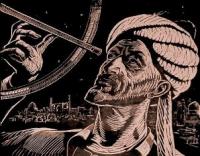You are here
Ulugbek Mohammed Taragay.


Walks in Uzbekistan.
“He who conquers himself is the mightiest warrior”
Confucius.
Exclusive tours in Uzbekistan.
After the death of Tamerlane, internecine wars and feudal riots broke out, ending in the victory of Tamerlan’s son Shahrukh. He chose the city of Herat as his residence so as not to be in Samarkand. He gave Maveronahr, as possession of the crown, to his eldest son Ulugbek (1394 - 1449).
Forty years, from 1409 to 1449 - the year of his tragic death, Ulugbek ruled the country. During his reign, Samarkand became one of the world centers of medieval science. In Samarkand, in the first half of the 15th century, a whole scientific school was formed around Ulugbek, which united prominent astronomers and mathematicians such as Giyaz-ad-din Jemshid Kashi, Kazi-zade Rumi, Ali Kushchi, and others.
At that time, the historian Hafiz-i-Abru lived in Samarkand, who wrote a remarkable work on the history of Central Asia; famous healer Mavlono Nefis, poets Siraj-ad-din Samarkandi, Sakkaki, Lufti, Badakhshi and others.
They were progressive people of the time who believed in the power of the human mind and in the power of science. It was Ulugbek who began the transformation of the Registan square by building the first of three madrasahs that formed the modern look of the square - “Ulugbek Madrasah”.
Ulugbek is also known in history as the creator of a unique observatory for that time. Ulugbek Mohammed Taragay was born on March 22, 1394. Grandson of Timur. In 1409 he was declared the ruler of Samarkand, and after the death of his father Shahrukh became the head of the Timurid dynasty.
Science Ulugbek began to get involved in youth, the rich library gathered by his father, in which young Ulugbek spent most of his time, contributed to expanding his horizons. He loved poetry, studied history, but his main focus was on astronomy.
Becoming a ruler, Ulugbek attracted prominent scientists of his time to Samarkand, with the help of which he built his observatory. Ulugbek with its scientific research caused hatred among Muslim fanatics. And his life ended tragically:
he was brutally killed on October 27, 1449 with a terrible blow of a sword, with which the killer cut off his head with such force that, according to the chronicler, she jumped to another corner of the yard. The son and heir of Ulugbek, who practically gave his famous father to reprisal, having learned about his death during the Hajj to Mecca, did not even wonder what they did to the body of the decapitated great scientist. But Ulugbek in extreme haste, somehow, shamefully casually buried in the cemetery of the village, where he was killed.
And only by order of the ruler of Maverannahar, who replaced his son, mercilessly removed his father from his path, did the remains of Ulugbek be transferred to the family crypt - the mausoleum of Gur-Emir, and on the tombstone carved an inscription mentioning that the scientist had died at the hands of the father-killer.
Ulugbek was buried as a man who died a violent death, not in a shroud, but in silk underwear.
Enlightener:
"Religious and spiritual monuments of Central Asia." Author M. Khashimov. Saga Publishing, 2001







